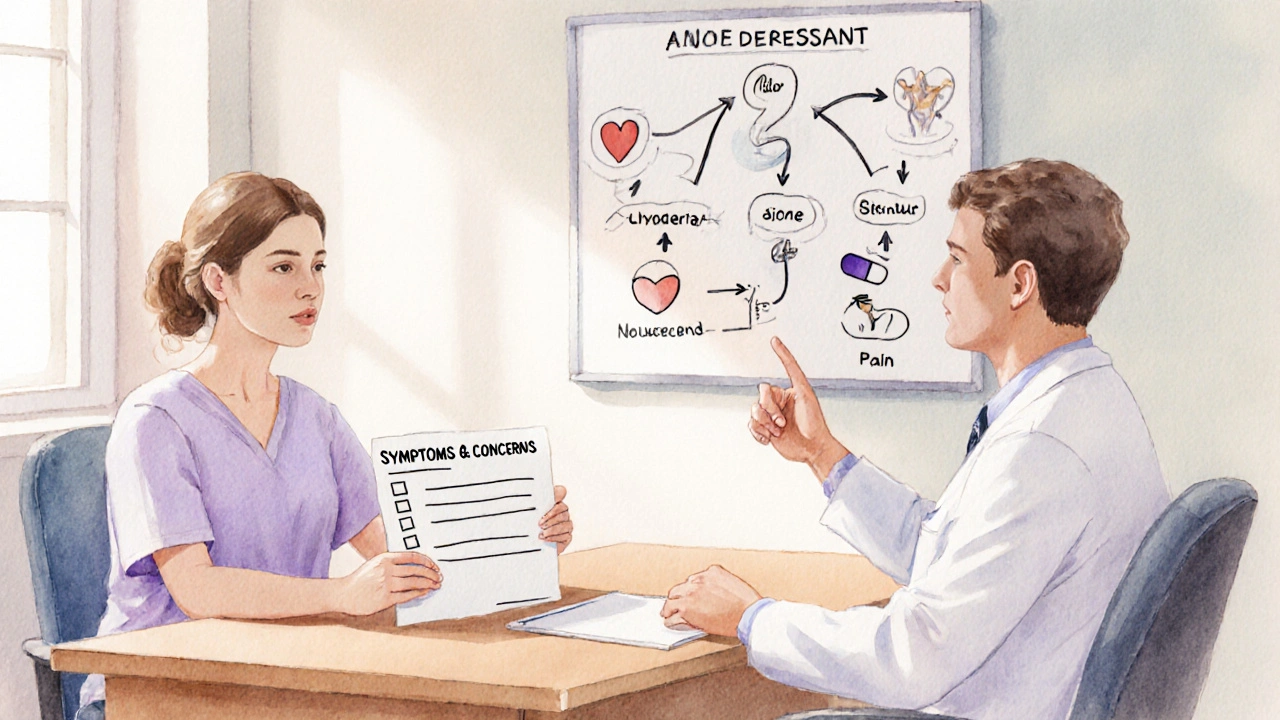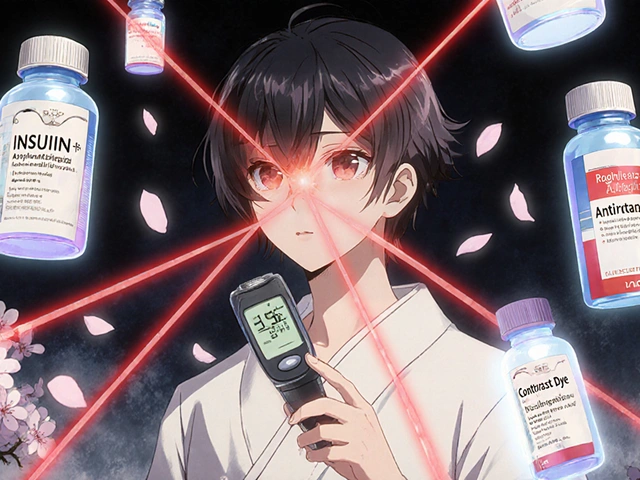Antidepressant Comparison Tool
Find Your Best Antidepressant Option
Answer a few questions about your symptoms and concerns to see which antidepressants might work best for you based on clinical evidence.
What's your primary concern?
Any medical conditions to consider?
Trying to decide if Daxid is the right choice for you? You’re not alone. Millions of people with depression or anxiety start on sertraline and then wonder whether a different pill might work better, cause fewer side effects, or fit their lifestyle. This guide walks you through the most frequently prescribed alternatives, breaks down what matters when you compare them, and gives you a clear checklist so you can talk to your doctor with confidence.
Key Takeaways
- Daxid is a brand of sertraline, an SSRI that balances serotonin levels in the brain.
- Most alternatives belong to the same SSRI class, but a few are SNRIs or atypical antidepressants with different mechanisms.
- Typical side‑effect profiles differ: sexual dysfunction is common with SSRIs, while nausea and blood‑pressure changes appear more with SNRIs.
- Cost, drug interactions, and personal health factors (like migraine history or hypertension) often decide which option is best.
- Work with your prescriber to try a 4‑ to 6‑week trial, then evaluate effectiveness and tolerability before switching.
What is Daxid (Sertraline)?
Daxid is a branded formulation of sertraline hydrochloride, an selective serotonin reuptake inhibitor (SSRI) approved for major depressive disorder, panic disorder, obsessive‑compulsive disorder, post‑traumatic stress disorder, social anxiety disorder, and premenstrual dysphoric disorder. It works by blocking the reabsorption of serotonin, keeping more of the neurotransmitter available in the synaptic gap, which helps lift mood over several weeks.
Typical starting doses are 25mg once daily, titrated up to 200mg based on response. Because sertraline has a relatively long half‑life (about 26hours), once‑daily dosing is convenient, and missed doses are less likely to cause withdrawal symptoms compared with shorter‑acting antidepressants.
How to Compare Antidepressants - Decision Criteria
Before diving into the alternatives, it helps to know the key factors that clinicians and patients weigh when swapping one medication for another.
- Mechanism of action: SSRIs increase serotonin; SNRIs raise both serotonin and norepinephrine; atypicals hit other pathways.
- Efficacy for specific conditions: Some drugs work better for anxiety, others for chronic pain or sexual dysfunction.
- Side‑effect profile: Weight gain, insomnia, sexual side effects, gastrointestinal upset, blood‑pressure changes, etc.
- Drug‑interaction risk: CYP450 enzyme metabolism can lead to serious interactions with certain antibiotics, antifungals, or heart meds.
- Cost & insurance coverage: Generic options are usually cheaper than brand‑name pills.
- Patient‑specific factors: Age, liver/kidney function, pregnancy status, and personal history of side effects.
Popular Alternatives to Daxid
Below are the most widely prescribed antidepressants that people consider when Daxid isn’t a perfect fit.
Paroxetine (Paxil)
Paroxetine is an SSRI known for its strong anxiety‑reducing effects. Typical doses range from 10mg to 60mg daily. It’s often chosen for patients with high‑level panic or social anxiety, but it also carries a higher risk of weight gain and withdrawal symptoms if stopped abruptly.
Fluoxetine (Prozac)
Fluoxetine is an SSRI with a long half‑life (about 4‑5 days), which makes tapering easier. Starting doses are 20mg daily, sometimes increased to 80mg. It’s frequently used for patients who need a once‑weekly dosing option (via its extended‑release form) or who have experienced activation (restlessness) with shorter‑acting SSRIs.
Citalopram (Celexa)
Citalopram is a mid‑range SSRI often prescribed for mild‑to‑moderate depression. Doses run from 20mg to 40mg daily. It’s well‑tolerated but may cause QT‑interval prolongation at higher doses, so cardiac monitoring is recommended for patients with heart rhythm issues.
Escitalopram (Lexapro)
Escitalopram is the S‑enantiomer of citalopram, offering slightly stronger serotonin reuptake inhibition. Typical dosing is 10mg to 20mg daily. It often shows faster onset of symptom relief and lower sexual side‑effect rates compared with many other SSRIs, making it a popular first‑line choice.
Venlafaxine (Effexor XR)
Venlafaxine belongs to the serotonin‑norepinephrine reuptake inhibitor (SNRI) class. Starting dose is 37.5mg daily, building up to 225mg. It’s useful for patients who need additional norepinephrine boost for pain or severe fatigue, but it can raise blood pressure at higher doses, so monitoring is essential.
Duloxetine (Cymbalta)
Duloxetine is another SNRI that also treats chronic musculoskeletal pain and diabetic neuropathy. Daily doses range from 30mg to 120mg. It shares the blood‑pressure concern with venlafaxine and can cause dry mouth, but many patients appreciate the dual mood‑pain relief.
Bupropion (Wellbutrin)
Bupropion is an atypical antidepressant that primarily inhibits norepinephrine‑dopamine reuptake. Doses start at 150mg once daily, often split into twice‑daily dosing up to 450mg. It’s the go‑to option for those who experience sexual dysfunction on SSRIs, but it can raise seizure risk at high doses and may increase anxiety in some users.
Side‑Effect Snapshot - How the Alternatives Stack Up
Understanding the most common adverse effects helps you anticipate what to watch for during the first few weeks.
| Medication | Class | Common Side Effects | Notable Advantages | Key Cautions |
|---|---|---|---|---|
| Daxid (Sertraline) | SSRI | Sexual dysfunction, nausea, insomnia, diarrhea | Well‑studied, low interaction risk | May cause serotonin syndrome if combined with MAOIs |
| Paroxetine | SSRI | Weight gain, fatigue, withdrawal symptoms | Strong anxiety relief | High discontinuation syndrome |
| Fluoxetine | SSRI | Activation, insomnia, dry mouth | Long half‑life eases tapering | Potential drug interactions via CYP2D6 |
| Citalopram | SSRI | QT prolongation (high doses), nausea | Generally well‑tolerated | Cardiac monitoring >40mg |
| Escitalopram | SSRI | Less sexual dysfunction, mild headache | Fast onset, fewer side effects | Cost higher than generic SSRIs |
| Venlafaxine | SNRI | Increased blood pressure, nausea, sweating | Effective for pain and fatigue | BP monitoring required |
| Duloxetine | SNRI | Dry mouth, constipation, hypertension | Treats both mood and chronic pain | Not ideal for uncontrolled hypertension |
| Bupropion | Atypical | Insomnia, dry mouth, anxiety | Low sexual side‑effect risk | Seizure threshold; avoid if history of seizures |

Choosing the Right Alternative - Practical Guidance
Every person’s brain chemistry and health picture is different, so there’s no one‑size‑fits‑all answer. Here’s a quick decision tree you can use during your next appointment:
- If sexual dysfunction is the biggest complaint, ask about Bupropion or Escitalopram.
- If you need extra relief for chronic pain or fibromyalgia, Duloxetine or Venlafaxine may be worth a try.
- If anxiety is the dominant symptom, Paroxetine or Escitalopram often outperform other SSRIs.
- If you have a history of heart rhythm issues, steer clear of high‑dose Citalopram and consider Fluoxetine with cardiac monitoring.
- For cost‑sensitivity, generic sertraline (Daxid’s generic) and generic fluoxetine are usually the cheapest options.
Always give a new medication at least 4 weeks at a therapeutic dose before judging its effectiveness, unless side effects become intolerable. If you need to switch, a brief taper of sertraline followed by a wash‑out period (usually 5‑7 days) can lower the risk of serotonin syndrome, especially when moving to an SNRI.
Questions Patients Frequently Ask
Can I switch from Daxid to another antidepressant without a wash‑out period?
Can I switch from Daxid to another antidepressant without a wash‑out period?
Because sertraline has a relatively long half‑life, some clinicians feel comfortable a direct switch to another SSRI, especially if the new drug also has a long half‑life (e.g., fluoxetine). However, moving to an SNRI or atypical agent often warrants a 5‑day gap to reduce serotonin syndrome risk. Always follow your prescriber’s taper plan.
Do any of the alternatives work faster than Daxid?
Escitalopram and fluoxetine sometimes show improvement within 2‑3 weeks, while sertraline often takes 4‑6 weeks. Venlafaxine can have a more rapid effect on pain symptoms, but mood benefits still follow the usual timeline.
Is it safe to combine Daxid with over‑the‑counter supplements?
St.John’s Wort is a notorious interaction-it can trigger serotonin syndrome when taken with sertraline. Most other vitamins and minerals are low risk, but always check with a pharmacist if you’re considering herbal products.
What should I do if I experience sexual side effects?
First, talk to your doctor. Options include dose reduction, switching to escitalopram or bupropion, or adding a low‑dose phosphodiesterase‑5 inhibitor (for men). Lifestyle tweaks like regular exercise can also help.
Are there any foods I should avoid while on sertraline?
Sertraline does not have major dietary restrictions, but excessive alcohol can increase sedation and liver strain. Grapefruit juice can affect CYP3A4 metabolism of some SSRIs, though the effect on sertraline is modest.
Next Steps for You
1. List the symptoms that bother you most (e.g., sexual side effects, anxiety, pain).
2. Match those concerns to the decision tree above.
3. Bring this list to your next appointment and ask specifically about the alternative that aligns best.
4. If you start a new drug, keep a weekly symptom diary for at least six weeks - note mood, energy, side effects, and any new health changes.
5. Review the diary with your prescriber; adjustments are common and part of the process.
Switching antidepressants can feel daunting, but with clear criteria and a solid plan, you’ll be able to find a medication that supports your mental health without unwanted side effects.








Kelly Thomas
October 13, 2025 AT 20:49Daxid (sertraline) is a solid first‑line SSRI, but it isn’t a one‑size‑fits‑all solution. If you’ve hit the dreaded sexual side‑effect wall, Bupropion or Escitalopram can be a lifesaver. For folks wrestling with chronic pain, Duloxetine and Venlafaxine bring that extra norepinephrine boost that sertraline lacks. Remember that SNRIs can nudge your blood pressure upward, so keep an eye on your cuff readings if you go that route. Cost‑conscious patients often stick with generic sertraline or fluoxetine because the price difference is huge. A long half‑life like fluoxetine’s can make tapering smoother if you ever need to switch. When you have a history of seizures, steer clear of Bupropion because of its seizure threshold risk. Pregnancy? Paroxetine is generally avoided, so discuss alternatives like sertraline or citalopram with your OB‑GYN. Weight gain worries? Escitalopram tends to be weight‑neutral, and Bupropion even leans toward modest loss. If insomnia is a big problem, try taking the dose earlier in the day or consider a less sedating agent like Bupropion, but watch for the flip side of more wakefulness. Some patients find that a direct switch from sertraline to another SSRI works fine thanks to the long half‑life, but always ask your prescriber about a wash‑out when jumping to an SNRI. Keep a weekly symptom diary for at least six weeks – note mood, energy, sleep, and any odd side effects. Bring that diary to every follow‑up; it’s your strongest negotiating chip. Lastly, never change or stop a med on a whim – abrupt stops can trigger withdrawal or serotonin syndrome. With a systematic approach, you’ll land on a medication that eases your symptoms without the baggage.
Patricia Bokern
October 21, 2025 AT 09:23Honestly, the pharma lobby is probably pulling the strings behind every brand name.
Darci Gonzalez
October 28, 2025 AT 21:56Hey! Just wanted to say you’re not alone on the side‑effect roller coaster 😊
Many folks shuffle between sertraline and bupropion without a hitch.
If the sexual stuff is too much, dropping the dose a bit can sometimes help.
And don’t forget to check vitamin D – it can boost your mood too! 🌞
Marcus Edström
November 5, 2025 AT 10:29Sertraline works for a lot of people, but if you’re not feeling it, exploring an SNRI is worth a chat with your doc.
Aaron Miller
November 12, 2025 AT 23:03Look, the American medical establishment loves pushing cheap SSRIs like sertraline because they’re made in bulk and line the pockets of big pharma; if you want real change, start demanding generics that actually prioritize patient outcomes over profit!!!
Roshin Ramakrishnan
November 20, 2025 AT 11:36Great overview! I’d add that for patients with hypertension, monitoring blood pressure when starting duloxetine or venlafaxine is essential; the literature shows a dose‑dependent rise in systolic pressure.